Please tell me if the question's vogue, I need the answe as soon as possible
for more information about the problem you can refer to this. I just didn't understand how to manage buffers properly.
A red rectangle drawn on 2D texture disappears right after being drawn
Being in the last stages of customizing the class COpenGLControl:
I have created two instances of the class in my MFC Dialog:

whenever the extent of zoom is changed in the bigger window, it is drawn as a red rectangle on the smaller window. which is always in full extent mode. In order to stablish such a relation between two instances, I have used the concept of user defined messages and send the message to the parent of the class.
The main trouble
based on the information above:
1- when I pan in the bigger window (mean I cause the user defined message be sent rapidly and m_oglWindow2.DrawRectangleOnTopOfTexture() be called rapidly I see a track of red rectangles shown but immediately disappeared in the smaller window
2- CPU-usage immediately get's high when panning from 3% to 25%
3- In other navigation tasks liked Fixed zoom in,Fixed zoom out,Pan and etc a red rectangle flashes and then immediately disappears, I mean it seems that the red rectangle is there just when the control is in the function m_oglWindow2.DrawRectangleOnTopOfTexture() but I want the rectangle be there until the next call off m_oglWindow2.DrawRectangleOnTopOfTexture()
4- making calls to glDrawBuffer(GL_FRONT_AND_BACK) and glClear(GL_COLOR_BUFFER_BIT | GL_DEPTH_BUFFER_BIT) causes the texture in the smaller window to get off and on even if the mouse is idle
I know the problem is most because of the lines glClear, glDrawBuffer, SwapBuffers in the following codes. But I don't know exactly how to solve
void COpenGLControl::OnTimer(UINT nIDEvent)
{
wglMakeCurrent(hdc,hrc);
switch (nIDEvent)
{
case 1:
{
// Clear color and depth buffer bits
glClear(GL_COLOR_BUFFER_BIT | GL_DEPTH_BUFFER_BIT);
// Draw OpenGL scene
oglDrawScene();
// Swap buffers
SwapBuffers(hdc);
break;
}
default:
break;
}
CWnd::OnTimer(nIDEvent);
wglMakeCurrent(NULL, NULL);
}
void COpenGLControl::DrawRectangleOnTopOfTexture()
{
wglMakeCurrent(hdc, hrc);
//glDrawBuffer(GL_FRONT_AND_BACK);
//glClear(GL_COLOR_BUFFER_BIT | GL_DEPTH_BUFFER_BIT);
glPushAttrib(GL_ENABLE_BIT|GL_CURRENT_BIT);
glDisable(target);
glColor3f(1.0f,0.0f,0.0f);
glBegin(GL_LINE_LOOP);
glVertex2f(RectangleToDraw.at(0),RectangleToDraw.at(1));
glVertex2f(RectangleToDraw.at(0),RectangleToDraw.at(3));
glVertex2f(RectangleToDraw.at(2),RectangleToDraw.at(3));
glVertex2f(RectangleToDraw.at(2),RectangleToDraw.at(1));
glEnd();
glPopAttrib();
SwapBuffers(hdc);
wglMakeCurrent(NULL, NULL);
}
void COpenGLControl::OnDraw(CDC *pDC)
{
// TODO: Camera controls
wglMakeCurrent(hdc,hrc);
glLoadIdentity();
gluLookAt(0,0,1,0,0,0,0,1,0);
glTranslatef(m_fPosX, m_fPosY, 0.0f);
glScalef(m_fZoom,m_fZoom,1.0);
wglMakeCurrent(NULL, NULL);
}
Remember:
OnDraw function is just called twice in the smaller window first when initializing the window and second when calling m_oglWindow2.ZoomToFullExtent() and then for each call of OnDraw in the bigger window, there's a call to the DrawRectangleOnTopOfTexture() in the smaller one but this function DrawRectangleOnTopOfTexture() is never called in the bigger window
It'll be favor of you if:
you correct my code
introduce me an excellent tutorial on how to use buffers in multiple drawings that can not be done in a single function or a single thread (An excellent tutorial about buffers eg.color buffers and etc in opengl
------------------------------------------------------------------------------------------ -----------------------------------------------------------------------------------------
I just added explanations below to provide further information about how's the class is working if it's needed. If you think it's bothering viewers just edit it to remove which of the parts that you feel is not required. But please do help me.
the oglInitialize sets initial parameters for the scene:
void COpenGLControl::oglInitialize(void)
{
// Initial Setup:
//
static PIXELFORMATDESCRIPTOR pfd =
{
sizeof(PIXELFORMATDESCRIPTOR),
1,
PFD_DRAW_TO_WINDOW | PFD_SUPPORT_OPENGL | PFD_DOUBLEBUFFER,
PFD_TYPE_RGBA,
32, // bit depth
0, 0, 0, 0, 0, 0, 0, 0, 0, 0, 0, 0, 0,
24, // z-buffer depth
8,0,PFD_MAIN_PLANE, 0, 0, 0, 0,
};
// Get device context only once.
hdc = GetDC()->m_hDC;
// Pixel format.
m_nPixelFormat = ChoosePixelFormat(hdc, &pfd);
SetPixelFormat(hdc, m_nPixelFormat, &pfd);
// Create the OpenGL Rendering Context.
hrc = wglCreateContext(hdc);
wglMakeCurrent(hdc, hrc);
// Basic Setup:
//
// Set color to use when clearing the background.
glClearColor(0.0f, 0.0f, 0.0f, 1.0f);
glClearDepth(1.0f);
// Turn on backface culling
glFrontFace(GL_CCW);
glCullFace(GL_BACK);
// Turn on depth testing
glEnable(GL_DEPTH_TEST);
glDepthFunc(GL_LEQUAL);
// Send draw request
OnDraw(NULL);
wglMakeCurrent(NULL, NULL);
}
example of a navigation task:
PAN:
void COpenGLControl::OnMouseMove(UINT nFlags, CPoint point)
{
// TODO: Add your message handler code here and/or call default
if (WantToPan)
{
if (m_fLastX < 0.0f && m_fLastY < 0.0f)
{
m_fLastX = (float)point.x;
m_fLastY = (float)point.y;
}
int diffX = (int)(point.x - m_fLastX);
int diffY = (int)(point.y - m_fLastY);
m_fLastX = (float)point.x;
m_fLastY = (float)point.y;
if (nFlags & MK_MBUTTON)
{
m_fPosX += (float)0.05f*m_fZoomInverse*diffX;
m_fPosY -= (float)0.05f*m_fZoomInverse*diffY;
}
if (WantToSetViewRectangle)
setViewRectangle();
OnDraw(NULL);
}
CWnd::OnMouseMove(nFlags, point);
}
the most important part: before calling OnDraw in each of the navigation functions if the client-programmer has set WantToSetViewRectangle as true means that he wants the view rectangle for the window to be calculated and calls setViewRectangle() which is as follows. It sends a message to the parent in case of an update for ViewRectangle:
void COpenGLControl::setViewRectangle()
{
CWnd *pParentOfClass = CWnd::GetParent();
ViewRectangle.at(0) = -m_fPosX - oglWindowWidth*m_fZoomInverse/2;
ViewRectangle.at(1) = -m_fPosY - oglWindowHeight*m_fZoomInverse/2;
ViewRectangle.at(2) = -m_fPosX + oglWindowWidth*m_fZoomInverse/2;
ViewRectangle.at(3) = -m_fPosY + oglWindowHeight*m_fZoomInverse/2;
bool is_equal = ViewRectangle == LastViewRectangle;
if (!is_equal)
pParentOfClass ->SendMessage(WM_RECTANGLECHANGED,0,0);
LastViewRectangle.at(0) = ViewRectangle.at(0);
LastViewRectangle.at(1) = ViewRectangle.at(1);
LastViewRectangle.at(2) = ViewRectangle.at(2);
LastViewRectangle.at(3) = ViewRectangle.at(3);
}
this is how we use the class in the client code:
MyOpenGLTestDlg.h
two instances of class:
COpenGLControl m_oglWindow;
COpenGLControl m_oglWindow2;
MyOpenGLTestDlg.cpp
apply texture on the windows and set both of them to full extent in the OnInitDlg
m_oglWindow.pImage = m_files.pRasterData;
m_oglWindow.setImageWidthHeightType(m_files.RasterXSize,m_files.RasterYSize,m_files.eType);
m_oglWindow.m_unpTimer = m_oglWindow.SetTimer(1, 1, 0);
m_oglWindow2.pImage = m_files.pRasterData;
m_oglWindow2.setImageWidthHeightType(m_files.RasterXSize,m_files.RasterYSize,m_files.eType);
m_oglWindow2.m_unpTimer = m_oglWindow2.SetTimer(1, 20, 0);
m_oglWindow2.ZoomToFullExtent();
m_oglWindow.ZoomToFullExtent();
want pan, zoomtool and setViewRectangle be active for the bigger window but not for the smaller one:
m_oglWindow.WantToPan = true;
m_oglWindow.WantToUseZoomTool = true;
m_oglWindow.WantToSetViewRectangle = true;
handling the user-defined message in the parent. exchange the ViewRectangle data to the smaller window and draw the red rectangle:
LRESULT CMyOpenGLTestDlg::OnRectangleChanged(WPARAM wParam,LPARAM lParam)
{
m_oglWindow2.RectangleToDraw = m_oglWindow.ViewRectangle;
m_oglWindow2.DrawRectangleOnTopOfTexture();
return 0;
}
Here's the full customized class if you're interested in downloading it and fix my problem.